Wednesday, September 6th
Siem Reap, Cambodia to Sambor Prei Kuk (Kampong Thom), Cambodia
Another difficult night sleeping. We were up at about 6:30 though only got out of bed at 8:30 for a shower and to start packing. By 9:45 we had eaten breakfast and checked out so sat outside the entrance and chatted to the others in our group.
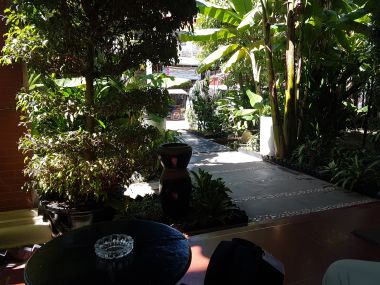
At 10:30 we returned to the sixth floor for Rous’ cooking demonstration where she had borrowed a few of the kitchen staff from the hotel and various pots and pans that were spread out on a table along with the various ingredients - All looking very tasty.
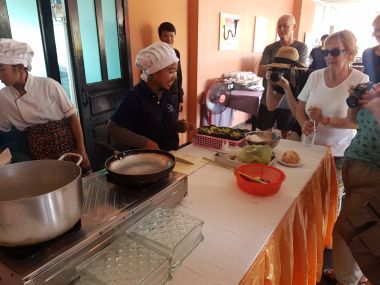
So, “Amok Vegetables” (with Rice which Marilyn was called on to help prepare separately in the kitchen):
Ingredients
- 3 kg broccoli/beans
- Spice mix:
- 1 lemongrass stalk (smashed)
- 4 finely chopped shallot
- 2 cm grated turmeric
- 1 crushed garlic clove
- 2 cm grated galangal
- 2 kaffir lime leaves (torn up)
- 1 finely diced red pepper (for colour)
- 4 cups coconut milk
- Sauce base:
- 1 dessert spoon chicken stock
- 1 tsp sugar
- 1 tsp fish sauce
- 1 tsp salt
Method
- Blanch vegetables and set aside.
- Put spice mix ingredients into pestle and mortar, grinding to a paste then set aside.
- Mix sauce base mixture and set aside.
- Add two cups of coconut milk into saucepan and take up to medium heat.
- Stir in big spoon of spice mix (approx 300g).
- Stir in tablespoon of sauce base.
- Stir in vegetables vegetables.
- Once mixed add remaining two cups of coconut milk.
- Simmer until all ingredients incorporated.
We gathered around the table to watch and took notes while Rous prepared the dish. Afterwards we sat with PJ and Steph to taste Rous’ cooking and it was quite tasty. We ended up talking, as I always tend to do, about food and they talked about food in the UAE which they seem to enjoy. Steph has had to learn how to cook for her Arabic fiance so is quite getting into it. Of course, the conversation did also get onto the role of women in UAE which is still quite backwards.
While we were eating, Rous’ charming two children showed up as they were on their way to school dressed in their school uniforms and, despite their obvious embarrassment, were introduced to everyone.
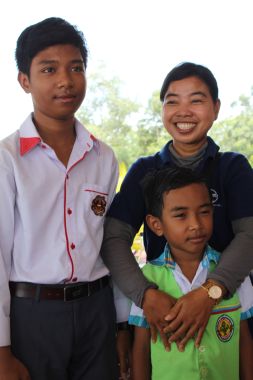
At 12:15 we boarded our new bus driven by a new driver for the next stage of our trip. We left Siem Reap and headed east. It is cloudy today and, thankfully, slightly cooler with a nice breeze. A temple…dog in dirt…people on bikes…red dirt…palm trees..petrol station (bottles in racks beside the road)…water buffalo wading in the rice paddies…cow tied under tree…It was a good road with very few potholes. Past motorcycles pulling wooden carts with car tires…enormous chicken sheds…incomprehensible billboards..very quiet in bus. A few people were dozing or listening to music. Houses on stilts…thatch, tile and metal roofs…laundry drying in the heat of the midday sun hanging from trees, lines or anywhere else it can be hung…I can see more activity today than on other days perhaps because it is cooler more people are out? Mango trees…fruit laid out for sale on ramshackle wooden tables…gold gates of yet another immaculate, gaudy temple…hammocks swaying in the breeze…bright flowers growing in the bushes…The bus is a bit hotter than the others we have been on which is quite nice as I did find the others had the air conditioning too cool (though I know most like it that way).
At about 1:30 we left the main road and travelled along a rust-coloured dust potholed-road then a short time later we stopped beside an ancient bridge for a comfort break (as you do).
“Spean (bridge) ‘Praeh Toeus’” (Spean Neak or Spean Kampong Kdei; see https://en.wikipedia.org/wiki/Spean_Praptos) is suspected to have been built late in the 12th century and is the longest of 22 bridges between the capital of Angkor to the provincial areas in the southeast. Crossing the Chikreng River the bridge is 86m long, 16m wide (two lanes of traffic divided by a line of stones) and 10m high. It is made from large rust-coloured bricks made of laterite and has railings much like we saw at the gates to Angkor Thom - A long seven-headed naga serpent. The bridge has once again been restored by the French and looks remarkable - To see this elaborate piece of archeology in the middle of quite a rural landscape is quite amazing.
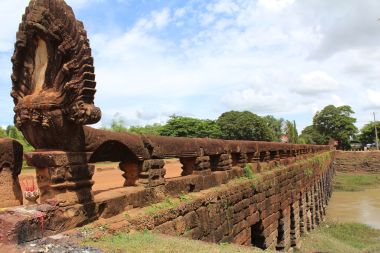
This is an obvious tourist stop with various vendors everywhere along with the expected hassle. A pile of empty beer boxes beside the road advertises the location of a small bar/restaurant where many of the group disappeared to use the toilets.
We took the time to stretch our legs, walking across the bridge. It is quite sleepy with only the occasional motorbike passing by. A few flea-bitten dogs attracted the attention of Marilyn again…Don’t touch!
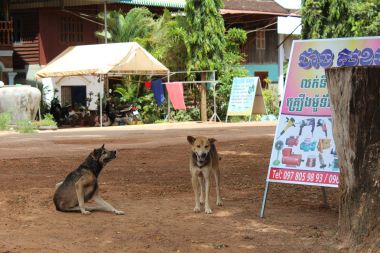
Back on the road again. Mel had acquired a flower during our stop…
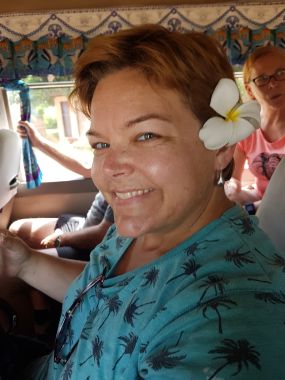
Ever present power lines parallel to the road…Rous having us try sticky rice balls with condensed milk…Our new driver is “Sony” who works for a company that serves Phnom Penh (our previous driver’s company serves Siem Reap)…wooden railings…metal railings…shrine on small island in middle of field…advertisements for beer on the sides of homes…”Depot Tela” (modern petrol station) selling petrol at 1,650 riel/liter (£0.31/liter)…haystack beside road…some cows with their bones clearly visible on their thin frames (though, perhaps unexpectedly, this is not the true for all of the cattle)…cooler containing cold drinks…mobile phone mast sticking up in the middle of a rice paddy…more anemic yellow petrol in plastic bottles under an umbrella in a wooden stand…a muddy brown stream…the large awnings of a market…the occasional house with a balcony overlooking the road or the never ending paddies stretching into the distance…a bunch of shops and larger buildings of a small town that we quickly leave behind us…large water lilies (lotus flowers) floating in the water…the sun now beating down upon the landscape…groupings of traders all selling the same thing (Rous tells us this is so that you know where you can find them as they are always in the same spot)…piles of firewood…people in the water of the fields up to their chest wading around…Wide dusty roads lead off left and right to small collections of buildings in the distance (this is obviously the main access road)…local flooding…a ceremony of some kind with people sitting around in plastic chairs under a large plastic awning with a mass collection of motorcycles nearby…another “Cambodia People’s Party” office…”Anchor Cement” billboard…more water buffalo with only their heads and horns visible chewing on their meal in the middle of a paddy…Most cows are tethered but some either have escaped or are allowed to roam freely. You would think it would damage the fields…rice spread out on large rattan mats boarded in red or blue drying in the sun…
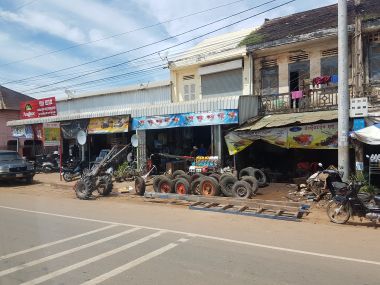
We stopped beside the road for another cultural demonstration. Here under a roof of wood beams and leaves they were pounding dried rice using a 4-5 m long wooden pole on a pivot with several people shifting their weight standing on top at the other end causing the pole to raise then come down on the rice (some rubber tires are used so that the pole can be bounced into the rhythm). A rather brave lady was removing the rice with her hands after it was pounded. The whole ground shook as the beam came crashing down. Of course several of our group offered to get up onto the beam to give it a try, lasting only a few minutes in the heat despite being under cover…It looks easier than it is. They get through about 100 kg of rice every day with the flour (powder) going to the pigs but the flakes are used for various dishes. The particular group we talked to had been there for 20 years and in the province for 32 years. It is an exhausting and, perhaps, monotonous life.
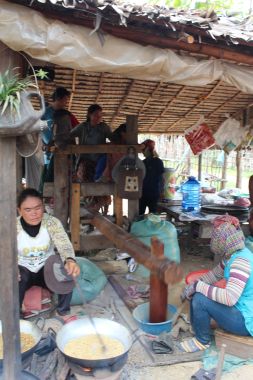
Yeah, a few of us gave it a try too…
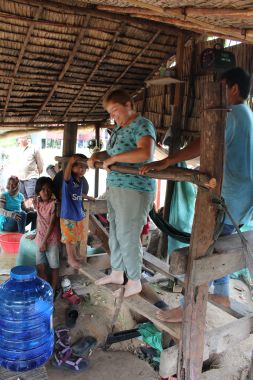
Marilyn bought some more frogs stuffed with sticky rice…no one else showed any interest!
We now entered the “Kampong Thom Province” region of Cambodia which we were told consists mostly of farmers though about 800,000 in the cities. Outside of the cities there are roughly 5 people/square kilometer. An interesting point from Rous when we pointed out several flooded areas was that Angkor Wat is away from water to avoid the regular rainy season flooding.
Pulling off of the main road we had to stop for a few minutes to let a herd of water buffalo cross. Of course we had to get out and get pictures…It is amazing to see these large animals completely submerged in the water with just their eyes and nose visible.
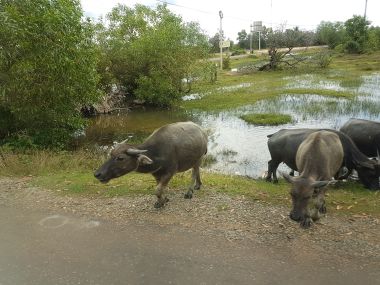
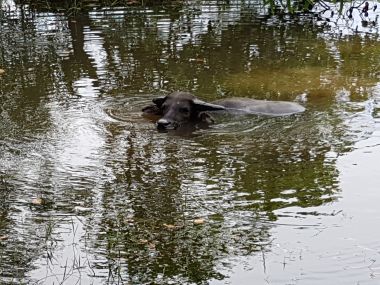
Throughout our travel we have seen these rather unusual multi-purpose carts that are being used. Basically it is an engine with tractor wheels and a very long set of handlebars to control it. These very strong looking machines are used to pull carts but we have seen them used to till the fields as well.
Our homestay is in the “Sambor Prei Kuk” area (“Sambor Village”) which also has the ruins of a number of temples (we were given the opportunity to visit them but since our time is so short no one wanted to do this). The road passed through the ruins under the trees which are quite startling since we have not seen evidence of any others all day today. A short distance around the corner along a dirt side road we arrived at the house at just before 4.
Rous did not know until today which family we would be staying with and had been cautioning us that the family may not speak a lot of English and that we may even be split into several groups. In our case we were lucky as Teng, our host, is an English teacher in the village living with his wife and two children and has a large, solidly built, house big enough for all of us (later we learned he had built the concrete ground floor himself but had help from the community with the rest of it which is quite common here). The cooking, dining and bathrooms (two large separate tiled rooms beside one another with flushing toilets and a shower hanging from the wall) areas are on the ground floor and a very large room upstairs that was already set up for our sleeping tonight with (single) thin mattresses, pillows, a light blanket, towel (we were shown by our host that this could be used in a number of ways including as a bathrobe) and blue bed nets all set up for us. He also has electricity which means we will have ceiling fans tonight though I quickly made sure I had a mattress beside an open window (we would even be able to charge our phones if we needed to…).
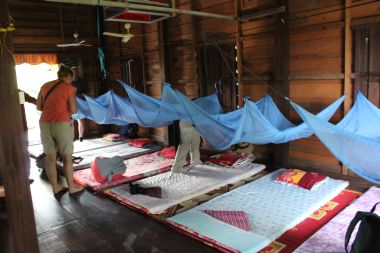
The ground floor is mostly concrete (to keep out the insects including, of course, termites) with a substantial concrete staircase with elaborate metal railings leading from the front of the house to the mostly wood second floor. A massive sheet metal roof protects the house from both the sun and the occasional substantial rainfall. The sandy compound is surrounded by brick walls that Teng is currently completing.
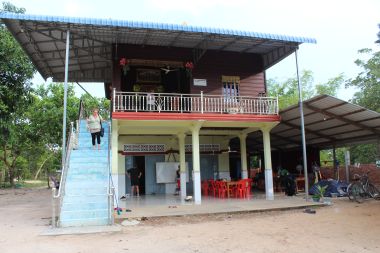
A large garden in the backyard provides fruit and vegetables (including papaya and mango that I could see) for the family and meat from the occasional chicken wandering about.
A large table surrounded by plastic garden chairs was set up for us on the ground floor which is largely open to the air to take advantage of any breeze. There was even several coolers filled with ice and drinks (two bottles of water each but we could have beer or soft drinks as well, marking down what we took to pay later - $1 each). This is obviously a teacher’s home with a large white board set up on an easel against the house and a number of children wandering around (not just his two).
Yeah, it is not exactly “roughing” it, for goodness sakes we even have WIFI! I had been quite worried about the homestay after a rather uncomfortable (though, admittedly, rewarding) homestay when I was in Africa but this was going to be a walk in the park by comparison. There is also the rest of the group here which really will help as before I was all alone (and no one spoke even basic English).
Dinner was well underway. A few of our group went into the kitchen to help cut up vegetables while the rest of us relaxed after another long day on the road talking to Teng about his life here in the village.
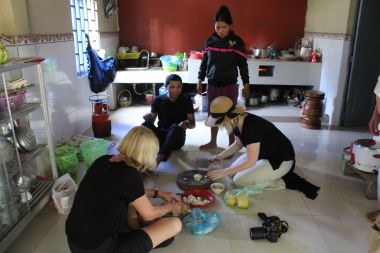
Occasionally a child would drive in or out of the compound on a scooter it seemed unlikely they could reach the pedals on. A group of water buffalo were herded past the compound entrance after a day in the fields. On the road outside the compound cows were tethered outside of each home alongside a basic wood cart though I am not sure how normal this was…I think this could be for our ride later…but I am getting ahead of myself.
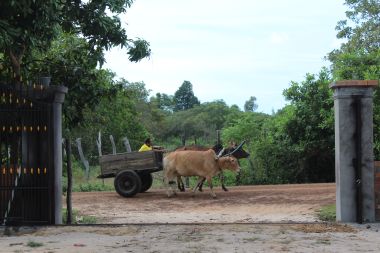
We played a game of football with some of the children and amused ourselves with badminton (have not played in years!). It was just nice to be out of the bus and have a bit of free time.
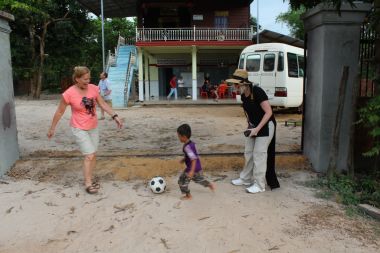
So we all opted for the ox cart ride - an “optional extra” at $6 each with two people per cart. Our carts were ready just after 5 so Mel and I clambered into the back of one of the carts which had been lined with a basic plastic mat.
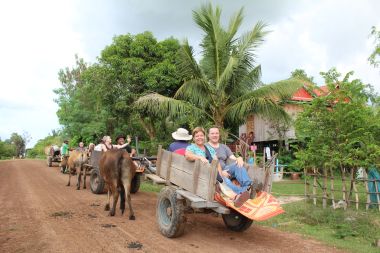
Two oxen pulled each of the carts in a convoy through the village then into the rice paddies. It was quite a peaceful, quiet journey at a leisurely pace and we were able to soak in a bit of the atmosphere. It was a bit bouncy and we made a bit of a game of it by warning those in the cart behind of any significant bumps so they could prepare themselves (it was particularly bumpy in the fields). The village consists of the dirt road with large tree-covered compounds containing fairly nice houses on either side. There were not many people around but those that were certainly gave us a friendly wave (which, of course, we returned).
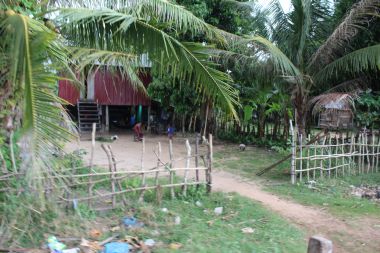
Taking a narrow path off of the road we passed by the houses and into the rice fields. They stretched as far as we could see in every direction with lines of trees delimiting each field.
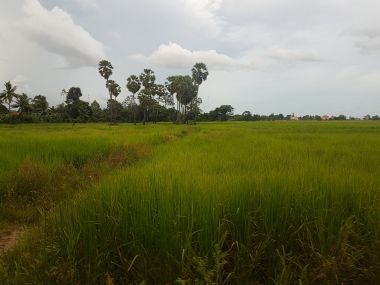
A short distance in we stopped so that Teng could explain about his life and farming. At our concern, he told us there are snakes living in the paddies but they are not venomous. He showed us the rice plant itself and how it grows. His family owns two fields on which he grows cashews (2 hectares) and Jasmine rice (1 hectare), the dominant crop here.
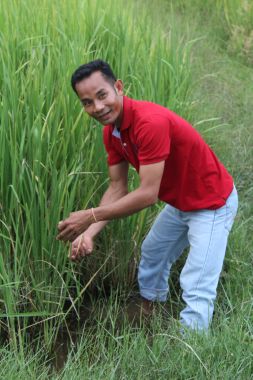
We took the long way back to the house, quite a distance through the rice fields being careful to mind the splash of mud from the tail of the oxen. It was here that was very bumpy and muddy. It was nice to be here in the peace watching the multi-coloured sunset with the silhouette of palm trees and listening to the frogs…only the occasional interruption of another tourist!
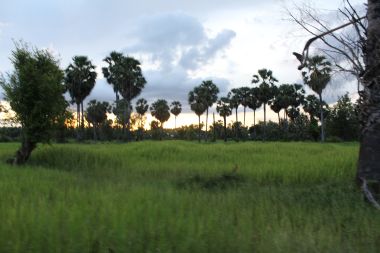
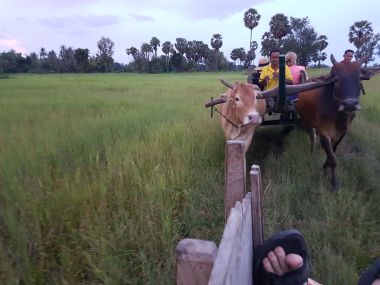

Dinner was ready when we got back to the house. It was quite nice but, of course, quite basic. A stir fry of pineapple, chicken and onion; an unusual pumpkin/egg dish; a light soup of cabbage, chicken and carrot; crispy fried shredded chicken; a side plate of small, sweet bananas; and beans with pork. Of course, served with his own Jasmine rice.
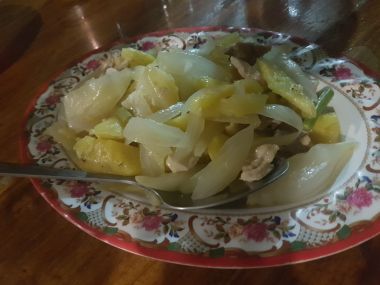
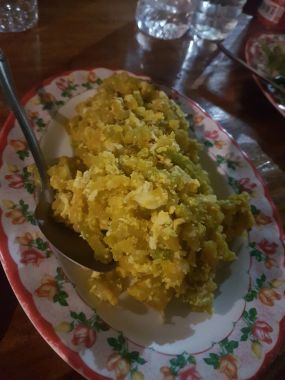
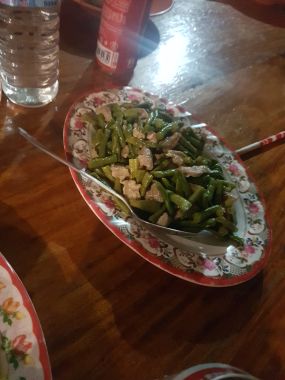
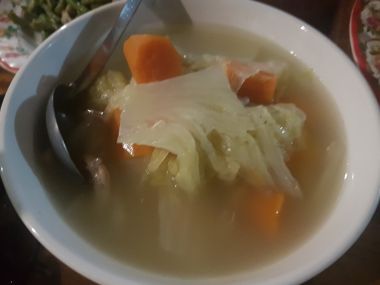
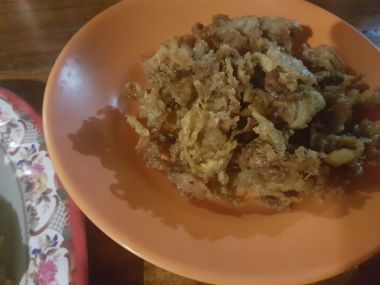
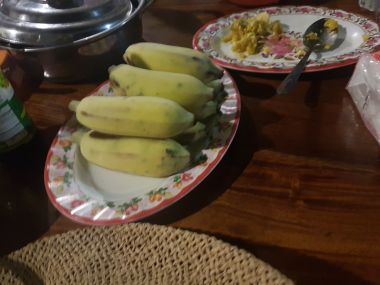
After dinner Teng explained he wanted us to help some of his students practice their English so we ended up splitting into smaller groups talking to the children. It was fun but we very quickly ran out of things to say or talk about though they were all charming and very nice. There were sheets containing pictures of fruit, animals and timestables that we used to test them on. Mel was not so good on the timestables herself so thinking perhaps she needs to spend some time in Teng’s classes…The pictures of various fruits was amusing as we did not know what half of them were! Sally and Tony, both retired teachers, seemed to be having quite a dynamic lesson on the whiteboard.
Afterwards we sat around and talked for a bit longer. Teng explained that the cows in the village are not eaten nor are they milked, they are only for working in the fields. He also said that there had been 25 homestays in the area when they first started and there was much enthusiasm but they are now down to only 9.
We headed upstairs to bed, remembering to take off our sandals before entering the room. Mel has taken the mattress beside mine (which is nice!) and Rous has a small room separate from the main one all to herself. Her nightclothes are quite pretty though she said I looked like a doctor in mine! I brushed my teeth and was embarrassed to find I had spit out in the wrong area…I explained to some of the others how to use the bed net, tucking it under the mattress. Mel and I are taking anti-malarials but it is still important to not take any unnecessary risks. I am quite sure there are others on the trip not taking any.
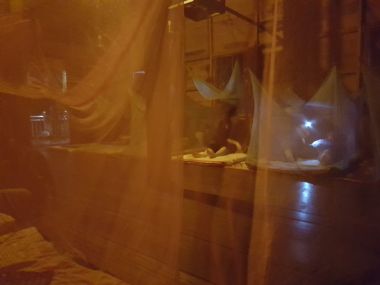
I think it might be uncomfortable trying to sleep tonight - Thin mattress, heat, very little breeze, bed net, full moon shining through the window beside me, someone snoring…